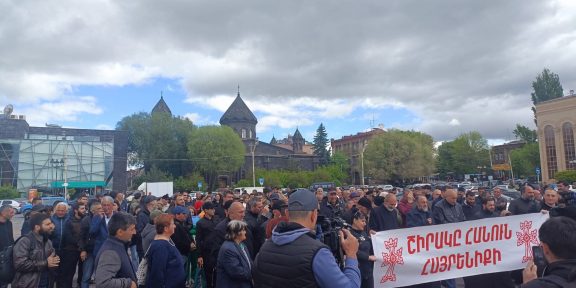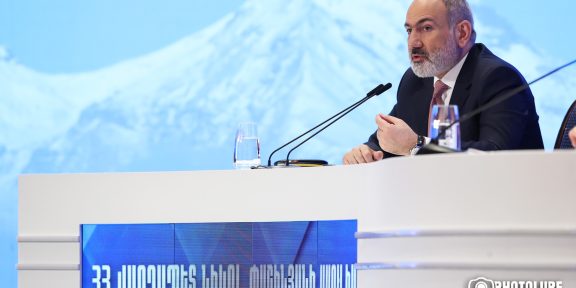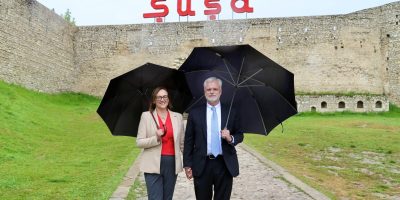By Mark Dovich
The European Union has expanded its aid offer to Armenia over the next five years by one billion euros, acting Prime Minister Nikol Pashinyan announced at a news conference on Saturday after meeting with European Council President Charles Michel. The aid package now totals up to 2.6 billion euros, equivalent to over $3 billion.
“We are by your side, and we reaffirm the EU’s readiness to be a constructive partner in solving problematic issues and promoting democratic values,” Michel said at the news conference, calling the aid package “unprecedented.” He continued: “The EU is ready to assist Armenia in its key priorities — infrastructure, the digital agenda, climate, transport, and democratic reforms.”
Observers and analysts have linked the offer of additional assistance to the successful conduct of last month’s snap parliamentary elections. The vote, which resulted in an unexpected landslide win for Pashinyan’s Civil Contract party, was deemed “free, competitive, and fair” by the Organization for Security and Cooperation in Europe. Pashinyan has himself described the expanded aid package as a “reaction to irreversible democratic processes taking place in Armenia.”
The aid proposal comes from the EU’s Eastern Partnership initiative, which brings together the EU and its 27 member states with six post-Soviet countries in an effort to “strengthen and deepen the political and economic relations” among the countries involved. The Eastern Partnership officially covers Armenia, Azerbaijan, Belarus, Georgia, Moldova, and Ukraine.
Armenia has received one of the largest aid packages of any offered to those six countries, especially on a per capita basis. Were the EU to invest the maximum amount of 2.6 billion euros in Armenia evenly over five years, the annual aid alone would represent nearly 5% of Armenia’s yearly GDP.
The updated aid package envisions spending for two additional projects, raising the total number of projects that the EU will support in Armenia over the next five years to seven — though it remains unclear exactly what those two new projects will entail.
In the initial draft plan released earlier this month, Brussels had committed 1.6 billion euros to Yerevan over the next half-decade to fund five “flagship” projects. Those five projects primarily cover infrastructure development and economic assistance for Armenian small businesses and tech start-ups.
Pashinyan has welcomed the offer of further EU funding, forecasting that the projects “can become truly fundamental for the development of our country’s infrastructure and economic growth.” He added: “Contacts between Armenia and the EU have never been as intense as they are now, which undoubtedly testifies to the mutual intention to develop relations.”
The single most expensive project in the aid package involves further work on the North-South Corridor, an incomplete highway project that aims to connect Georgia and Iran via Armenia. The undertaking, Armenia’s largest transport project since Soviet times, was begun in 2012, but remains only about 20% complete.
Pashinyan has said the government will soon put forward a tender for the construction of a particularly formidable section of the highway that would connect the town of Sisian with the village of Agarak, located on the strategically important Armenian-Iranian border.
Pouring Money into Southern Armenia
Syunik, Armenia’s southernmost province, stands to benefit handsomely from Brussels’ offer of economic assistance, with up to 80 million euros earmarked to support “housing, infrastructure, tourism, agriculture, education, health, and renewable energy” projects in the region, as well as to promote local small businesses. With a population of nearly 140,000 people, Syunik is one of Armenia’s smaller provinces by number of permanent residents.
The region has been particularly hard-hit by Armenia’s disastrous defeat in last year’s war with Azerbaijan in and around Karabakh. From 1994, the end of the first Karabakh War, to 2020, the territory to the east of Syunik was controlled by Armenian forces. During that time, the border, essentially, did not exist, and people and goods traveled freely between Armenia and the unrecognized Republic of Artsakh.
But by the time the Russia-brokered ceasefire was announced on November 10, the map had changed considerably. Currently, Azerbaijani forces are in control of all the territory ringing the former Nagorno-Karabakh Autonomous Oblast, as well as parts of the Soviet-era NKAO itself. As a result, Syunik now directly faces Azerbaijani-controlled territory, stationed by Azerbaijani troops, for the first time in over 25 years.
In an interview with CivilNet, former Deputy Prime Minister Vache Gabrielyan explained that before the war, many Syunik residents used land on both sides of the border for agriculture and animal husbandry. But since the autumn of 2020, those farmers have been unable to access land now under Azerbaijani control — and the Armenian government has yet to come out with a plan for compensating people whose living was dependent on now-inaccessible lands.
Acting Deputy Prime Minister Mher Grigoryan has also underscored the urgent need to strengthen Syunik’s “resilience” in the face of Azerbaijan’s military victories in and around Karabakh last year.
EU Leader on First Official Trip to Caucasus
Michel visited Armenia as part of his first trip to the Caucasus as European Council president. He visited Armenia on Saturday, Azerbaijan on Sunday, and Georgia on Monday. The visit comes on the heels of a previous trip to all three countries earlier this month by Olivér Várhelyi, the EU’s Commissioner for Neighbourhood and Enlargement.
Aside from the aid package, Michel discussed Brussels’ desire to help with peacemaking efforts in the region. In particular, Michel highlighted the need to tamper down divisive rhetoric in both Yerevan and Baku, delimit and demarcate the Armenia-Azerbaijan border, promote cross-border cooperation in transportation, and hold talks on the final status of Karabakh.
“We hope that it will be possible to resolve the issue of prisoners, minefield maps, and demarcation and delimitation of borders. We hope that it will be possible through negotiations to resolve the issue of the withdrawal of troops from the disputed territories in order to start discussions on cooperation and transport communications, which will contribute to economic development,” he said. “Let’s see what a positive, constructive role the EU can play.”
Michel specifically highlighted Brussels’ support for the work of the Minsk Group, which was formed by the OSCE during the first Karabakh war in the early 1990s and is meant to encourage peaceful resolution of the conflict between Armenia and Azerbaijan. France, Russia, and the United States co-chair the group.
Michel also provoked the ire of many Armenian social media users when he posted a picture of his visit to Tsitsernakaberd, Armenia’s official Armenian Genocide memorial complex — and pointedly did not mention the Armenian Genocide. “I have paid homage at Tsitsernakaberd to Armenian victims,” he wrote on Twitter.
“What’s the point of visiting Tsitsernakaberd if you can’t say why you’re there?” read one typical reply, from political scientist Karena Avedissian.
















